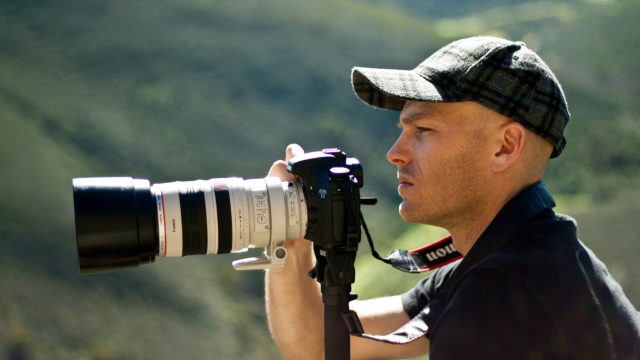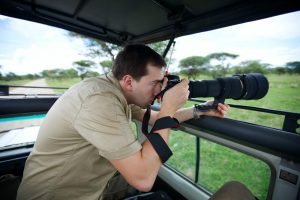James Kydd is a South African conservation biologist, photographer and private wildlife guide who’s had a love affair with the wild his whole life. He worked as a guide at Londolozi, one of South Africa’s top luxury bush lodges, for six years before starting Ranger Diaries, a multiple award-winning wildlife blog. Ranger Diaries features over 200 of Africa’s best wildlife photographers and guides sharing their first-hand experiences of the wilderness all over the continent, and also offers tailor-made safaris. As a private safari guide, James leads trips all over Africa. He was recently part of a National Geographic expedition to Botswana’s Okavango Delta.
Here he talks to Sarah Duff about the most underrated safari parks, what to look for when choosing a safari, and how to take excellent wildlife photos.
What do you love most about the bush?
The meditative thrill of following a fresh set of leopard tracks on a fresh winters morning.The thousands of untold stories, whether they be from the perspective of man or animal.
On a first trip to Africa, where would you suggest people go to see wildlife?
For the best wildlife in real wilderness: it’s very hard to beat Botswana’s Okavango Delta in its dry season. A place like this could spoil you forever though…
For walking safaris: Zambia’s South Luangwa National Park and Lower Zambezi National Park.
For amazing wildlife on a budget: Zimbabwe’s Mana Pools National Park.
For breathtaking herds: Kenya’s Maasai Mara National Reserve (choose the conservancies with vehicle restrictions surrounding the Mara otherwise the traffic jams can be horrendous) and Tanzania’s Grumeti Reserve.
For excellent guide and tracker teams: South Africa’s Londolozi Game Reserve and Singita.
What’s Africa’s most underrated park?
Kgalagadi Transfrontier Park: this part of the Kalahari Desert is full of unique life. Brown hyenas, aardvark, aardwolf, honey badgers, Cape and bat-eared foxes, families of meerkats, cheetah coalitions that hunt oryx, huge black-maned lions, brilliantly coloured finches, an impressive diversity of owls, huge flocks of beautiful sandgrouse, just to name a few….and all of this in photographically magic light bouncing off the red sand and dust.
What’s your favorite campsite?
I just returned from wonderful stay a campsite called Mabibi right up in the top corner of KwaZulu-Natal, South Africa, on the border of Mozambique. It’s tucked away behind a massive coastal dune on the outskirts of an ancient milkwood forest. There are only 10 secluded (and during the week mostly empty) campsites. We watched dolphins surfing the waves just off shore, humpback whales and their calves breaching not far behind them, snorkeled a beautiful reef with turtles and rays, saw red duiker (a tiny antelope) and an impressive variety of birds in the forest, and at night kicked up phosphorescence in the sand and fell asleep to the cries of thick-tailed bush babies.
What are your top tips for first-time safaris?
Be respectful: Like walking into a stranger’s home you have entered a world different to yours in the city. Have the best interests of the wildlife at heart. Respect any requests your guide may have, no matter how pedantic they may seem at the time.
Observe: when you come across something incredible or fascinating, hold the urge to ask questions or take photographs for a few moments and just soak up the atmosphere of what you are seeing.
Listen: It always fascinated me how often I might have stopped the car in the middle of a shallow river, under a glittering night sky, switched off the lights, and asked for total silence as the fireflies danced around us and a lion roared in the distance, only to have someone break the quiet with “Isn’t this amazing?” We have forgotten a respect for silence.
Slow down: Spend a long time with whatever you are watching, and avoid the temptation to constantly move on to the next thing.
Be patient: You are not in a zoo. Remove yourself from the world of instant gratification and you’ll feel a weight lift off your shoulders. Forget the Africa you saw on the documentaries and appreciate just being in the wilderness.
Walk: A walking safari opens up a whole new world, and you get to see so much more on foot, from tracks and bird nests to insects and plants.
What should people look for when choosing a safari holiday?
Get an excellent guide: Your safari guide can be the make-or-break of your safari experience. Even the top lodges can have guides that are poorly trained, and who lack passion, in depth-knowledge, and an acute awareness of their guests. Choose lodges with highly reputable guides, and if you have the budget, consider a professional host guide for the duration of your trip. You can find many of the top guides and rangers by searching for them online. Passage to Africa has excellent private guides (www.passagetoafrica.com/team/section/guides).
Seek intimacy: Try to find a destination where there are a maximum of six guests per vehicle, and where the vehicle numbers are restricted.
A lodge that conducts safaris in an open vehicle: It is much more thrilling, and the sensory experience is profoundly better, never mind the photographic possibilities.
Choose a reputable tour operator: The best operators will have intimate knowledge of most safari destinations, will have access to good rates at the lodges, and can tailor a safari experience you’re your specific needs. There are thousands of destinations, and thousands of ways to experience safari.
What are your top four tips for photographing wildlife?
Come prepared. I have seen so many guests arrive with wide-angle lenses wishing they had got a bigger lens for their safari. If you want to get decent close ups of wildlife you need a zoom or telephoto lens (300mm upwards). Consider renting the equipment if you are not sure you want to fork out for it just yet.
Request a photographic guide. Many safari guides are also photographers, and as such are better equipped to teach, anticipate shots through their knowledge of animal behavior, position vehicles correctly, make creative suggestions and understand your needs.
Get a private game drive vehicle. For serious photographers, consider getting a private vehicle so that you can spend as much time as you like with your subjects, and not have to consider the needs or impatience of other guests.
Bring a small beanbag for stabilizing your camera. You can make or buy one: get one with a zip so you can travel with it empty and not have the extra weight, and then get a bag of rice when you arrive at your destination country. Beanbags are easier to use in the vehicles than tripods or monopods and the extra stability will make a huge difference to the sharpness of your images.
What should travelers pack for an African safari?
Definitely binoculars, a broad-rimmed hat, comfortable shoes and neutral-coloured clothes for walking. Pack lightweight long-sleeve shirts and long pants that are breathable but that can protect you from mosquitoes in summer. For winter mornings on an open vehicle bring a beanie, scarf and gloves, but layer as it might warm up quite quickly. If you’re thinking of getting a bird or mammal book, consider an app for your tablet to save space and weight.
Follow James Kydd on Twitter @rangerdiaries and on Instagram @jameskydd.




